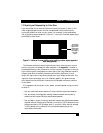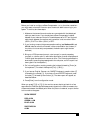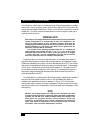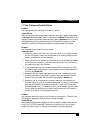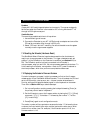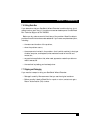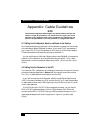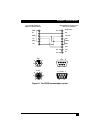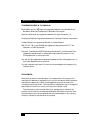
58
SERVSWITCH™ WIZARD EXTENDER
A.3 Twisted-Pair Cabling Between the Transmitter and Receiver
To interconnect the transmitter and receiver of your ServSwitch™ Wizard
Extender, you can use either shielded twisted pair (STP) or unshielded twisted pair
(UTP) rated to Category 5 or higher. It should be pinned straight-through and
paired according to the TIA-568A or (preferred) -568B specification, as shown in
Figure A-2.
CAUTION!
Do not use cables paired according to the USOC specification—Pin 1
with 2, 3 with 4, 5 with 6, and 7 with 8. These will work badly and will
yield a particularly horrible picture.
We recommend a solid-core CAT5 cable such as product codes EYN737MS
(preterminated) or EYN840A (unterminated bulk); specify the length you’d like when
you order. Terminate any unterminated cable with high-quality shielded RJ-45
plugs such as those in our FM732 (unshielded) and FM733 (shielded) 25-packs.
CAUTION!
Keep in mind that if you use shielded twisted-pair cable, the maximum
distance at which the Extender will operate will be at least cut in half, to
no farther than 100 m (325 ft.).
All twisted-pair cables are constructed in such a way that each of the twisted pairs
has a slightly different twist ratio. This is done to reduce the electrical crosstalk
between signals carried on adjacent pairs. Because of this, the wire distance that an
electrical signal has to travel is different for the different pairs. This does not
normally cause a noticeable problem—in fact, the twist differences have no effect
at all on digital signals such as network data. But if you’re sending higher video
resolutions (which are analog signals) across long cables, you might start to see
color separation caused by the red, blue, and green signals arriving at the receiver
at slightly different times.
If this happens, you might be able to improve your video by reterminating your
cable so that the video signals are on the pairs whose twist ratios are the closest to
each other. Most network-quality cables have one pair that’s much more tightly
twisted than the other three; this pair should be avoided. Unfortunately, different
manufacturers—and even different cable types by the same manufacturer—use
different pairs for the “tight pair,” so call your cable supplier. If they can’t tell you
which pair to avoid, cut a short section off the end of the cable, open it up, and
look at the pairs; the tight pair is usually quite obvious.




